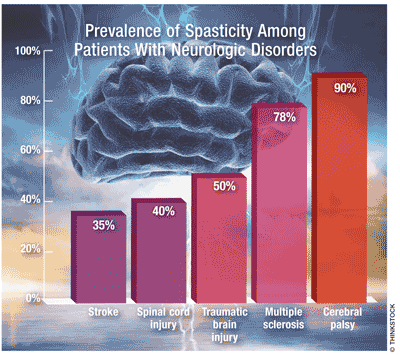US Pharm. 2014;39(1):74.
Spasticity was first described by William John Little, in 1843, as an electrical abnormality in the brain, spinal cord, or nerves. This neurologic condition affects the most basic functions of the 100 billion neurons of the brain. The imbalance of signals from the central nervous system to the muscles causes the muscles to contract, become stiff, or spasm involuntarily, making it difficult for the individual to walk, move, or talk. Spasticity may occur to some degree in most people secondary to a disorder or trauma, such as spinal cord injury, traumatic brain injury, cerebral palsy, stroke, or multiple sclerosis. According to the National Multiple Sclerosis Society, the rigidity from spasticity can help people with very weak legs to stand or walk. Spasticity is not associated with either sex or with any particular race or age group.

Conditions That Can Involve Spasticity
Traumatic Brain Injury: According to the CDC, the leading causes of traumatic brain injury are falls (35.2%), unknown/other (21%), motor vehicle accidents (17.3%), head strikes (16.5%), and assault (10%). Traumatic brain injury is a leading cause of disability in children and adolescents, and the two age groups at greatest risk are 0 to 4 years and 15 to 19 years. Among children aged 0 to 14 years, traumatic brain injury results each year in an estimated 2,685 deaths, 37,000 hospitalizations, and 435,000 emergency department visits.
Multiple Sclerosis: Some 350,000 to 500,000 individuals suffer from multiple sclerosis. Most cases are diagnosed in persons aged 20 to 50 years.
Spinal Cord Injury: The annual incidence of spinal cord injury—not including persons who die at an accident scene—is 12,000 new cases. The number of patients living with spinal cord injury is estimated to range from 238,000 to 332,000.
Stroke: Stroke is the nation’s fourth leading killer and a leading cause of long-term disability. Each year, about 795,000 people experience a stroke. On average, a stroke occurs every 40 seconds, and every 4 minutes someone dies from stroke. Deaths from ischemic stroke, the most common type, are predicted to nearly double between 2000 and 2032.
Treatment
While treatment for the medical condition related to the spasticity may be ongoing, spasticity itself can be treated. Therapies for spasticity include medications, rehabilitation, local injections, surgery, and occupational and physical therapy programs. Prescription medications for spasticity include muscle relaxants, sedatives, and nerve blockers. Spasticity occurs at a variable rate among patients with multiple sclerosis (78%), stroke (35%), traumatic brain injury (50%), cerebral palsy (90%), and spinal cord injury (40%).
To comment on this issue, contact rdavidson@uspharmacist.com.





